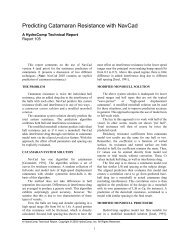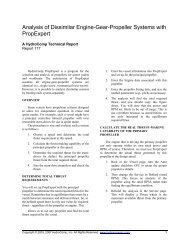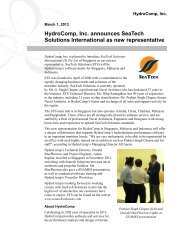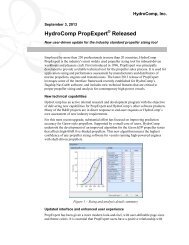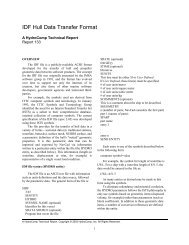Small Propeller Cup: - Hydrocomp Inc.
Small Propeller Cup: - Hydrocomp Inc.
Small Propeller Cup: - Hydrocomp Inc.
You also want an ePaper? Increase the reach of your titles
YUMPU automatically turns print PDFs into web optimized ePapers that Google loves.
The traditional criteria for cavitation are all<br />
empirically-derived functions of blade pressure<br />
(MacPherson, 1991). They were developed over time to<br />
represent relationships between amounts of cavitation<br />
and “average” blade pressure for conventional<br />
(uncupped) propellers. To use these criteria with<br />
cupped propellers, it is necessary to calculate two<br />
different thrust values – a performance thrust at the<br />
effective pitch and then a theoretical “cavitation thrust”<br />
calculated at the geometric pitch. Average blade<br />
pressure, subsequent levels of cavitation and thrust loss<br />
are then derived from this “cavitation thrust”.<br />
MEASUREMENT OF CUP<br />
Knowing how much cup to apply is only half of<br />
the battle. The other half is actually getting the proper<br />
cup onto the propeller. Using the geometric definition<br />
of cup corresponding to Hankley and Denny, this<br />
author suggests the use of a propeller cup gauge similar<br />
to that shown in Figure 3.<br />
Each gauge is labeled for the amount of trailing<br />
edge deformation (drop) in millimeters (e.g., 5 mm). It<br />
would have a step of the proper dimension (e.g., 5 mm)<br />
to measure the drop, and a radius of 7.5 times the drop<br />
(e.g., 37.5 mm) to measure the curvature. Two marks of<br />
0 and 30 degrees would be scored on the radius to show<br />
the extent of curvature. A typical propeller shop would<br />
have gauges in 1 mm increments up to 10 mm or so.<br />
5.0<br />
25.0 25.00<br />
HydroComp<br />
5mm <strong>Cup</strong> Gauge<br />
0<br />
30<br />
R37.5<br />
90.0<br />
(90%R), with a smooth transition to no cup at both<br />
extents. (One note of interest: a few companies have<br />
had some success in varying the cup distribution,<br />
typically with greater cup near the tip, in an attempt to<br />
fine-tune performance at various speeds.)<br />
CONCLUSION<br />
The simple geometric definition and performance<br />
model described above are intended to bring some<br />
sense of consistency to the community of propeller<br />
manufacturers, after-market propeller shops, naval<br />
architects and other marine professionals interested in<br />
cupped propeller performance. An earlier generation of<br />
the performance model implemented in a commercial<br />
software package (HydroComp, 1996) has been used<br />
successfully by dozens of marine professionals for<br />
numerous new and repowered vessels.<br />
Work is continuing to improve the performance<br />
model by segregating thrust and torque, by evaluating<br />
the effect of other propeller parameters (e.g., mean<br />
width ratio) and by refining the relationship with new<br />
data from model tests and sea trials, particularly for 4-<br />
and 5-bladed propellers of very high blade area.<br />
REFERENCES<br />
Blount, D.L. and Hubble, E.N., “Sizing Segmental<br />
Section Commercially Available <strong>Propeller</strong>s for <strong>Small</strong><br />
Craft”, SNAME <strong>Propeller</strong> Symposium, 1981.<br />
Denny, S.B., Puckette, L.T., Hubble, E.N., Smith, S.K.<br />
and Najarian, R.F., “A New Usable <strong>Propeller</strong> Series”,<br />
Marine Technology, Vol. 26, No. 3, July 1989.<br />
Hwang JL, Tsai JF and Li CY, “<strong>Cup</strong>ped <strong>Propeller</strong> Test<br />
and Analysis”, Ship Technology Research, Vol. 32,<br />
1995.<br />
Hankley, D.W. and Denny, S.B., “Performance<br />
Characteristics for a Series of Commercially Available<br />
<strong>Propeller</strong>s for <strong>Small</strong> Craft”, SNAME, San Diego<br />
Section, Feb 1983.<br />
87.5<br />
Figure 3 – <strong>Cup</strong> gauge<br />
Consistency of pitch and cup is very important, so<br />
industry practice is to apply the same amount of cup<br />
across the blade. Typically, the required cup would be<br />
fit from the mid-radius (40%-50%R) to near the tip<br />
HydroComp, <strong>Inc</strong>., HydroComp PropExpert program<br />
and documentation, 1996.<br />
MacPherson, D.M., “Reliable <strong>Propeller</strong> Selection for<br />
Work Boats and Pleasure Craft: Techniques Using a<br />
Personal Computer”, SNAME Power Boat Symposium,<br />
1991.<br />
4



